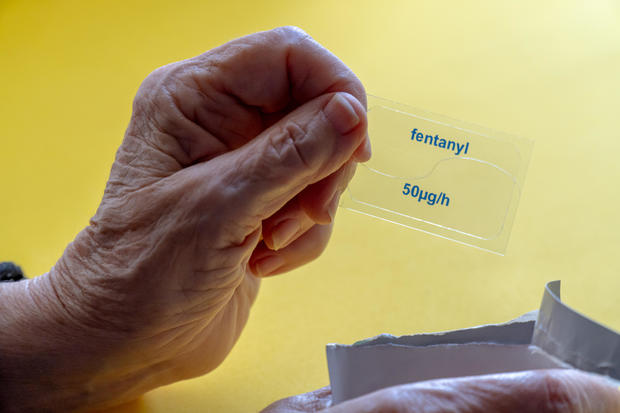Is fentanyl dangerous to touch? Experts say no – here's why
Fentanyl, a strong opioid about 50 times more powerful than heroin, has become increasingly present in the U.S. drug supply and has caused a wave of overdose deaths among people who consume it or use drugs they didn't realize were tainted with the substance.
On Nov. 8, 2023, several county elections offices in Washington state were evacuated after they received envelopes containing suspicious powder — including two that field-tested positive for fentanyl — while workers were processing ballots from the election the day before. A senior U.S. official familiar with the investigation told CBS News that roughly a dozen letters were sent to addresses in California, Georgia, Nevada and Oregon as well as Washington state.
The substance found on an unspecified number of the letters — not all of them, just some — included traces of fentanyl, the official said, adding that the substance overall was described as "nonharmful." The substance was identified using preliminary field tests, not more rigorous lab tests at FBI facilities, the official said.
The FBI warned all people to exercise care in handling mail, especially from senders they don't recognize.
However, experts in the fields of toxicology and public health have told CBS News that just touching or being near fentanyl won't cause an overdose. Here's what to know about fentanyl contact overdoses.
Can you overdose by touching fentanyl?
Experts told CBS News that touching fentanyl powder will not cause an overdose. In powder form, the way it's almost always found in the illicit drug supply, the drug cannot absorb through the skin, said Ryan Marino, a medical toxicologist, emergency physician and addiction medicine specialist at the Cleveland Medical Center. Just being near the substance also won't cause an overdose.
"Fentanyl as a dry powder is not going to cross through your skin. It's the same reason you can touch sugar without your blood sugar going up," said Marino. "Solids don't cross through your skin."
Major medical groups have also issued statements about the risk — or lack thereof — from touching fentanyl. In 2017, the American College of Medical Toxicology and the American Academy of Clinical Toxicology issued a joint position statement stating that "incidental dermal absorption is unlikely to cause opioid toxicity." One video, created by harm reductionist Chad Sabora, shows Sabora holding fentanyl and not having any adverse effects as he tests the substance.
If you do get fentanyl powder on your skin, Dr. Andrew Stolbach, a toxicologist and emergency medicine physician at Johns Hopkins Hospital in Baltimore, Maryland, said the treatment is simple: Just wash it off.
"If you see some powder on you, just wash it off, brush it off," said Stolbach. "After that, I wouldn't worry about it at all."
It's important to note that fentanyl found in the illicit drug supply is different from medical-grade fentanyl patches. These do adhere to the skin, but are formulated differently, are slow-releasing, and are primarily used in medical settings. Stolbach described the patches as "specially engineered medical devices" that "just barely delivers some clinically relevant amount of fentanyl." The patch includes fentanyl hydrochloride, a kind of salt that allows the medication in the patch to dissolve through the skin and enter the bloodstream.
"Even at peak absorption, if you covered both palms with fentanyl patches, it would take about 15 minutes to deliver just a standard dose," said Stolbach, who is also on the board of directors at the American College of Medical Toxicology. With powder fentanyl, "it's not fentanyl hydrochloride. It's not being held against your skin. It's just going to brush away when someone touches it. Everything's working against it. It's just a totally different scenario than the fentanyl patch."
Brandon del Pozo, a former police officer turned public health researcher who focuses on public health and substance use, compared it to a nicotine patch and a cigarette: "You can't just tape a cigarette to your arm instead of using a nicotine patch."
Can you overdose by ingesting or breathing in fentanyl?
Stolbach said that powder fentanyl can be absorbed by inhaling it, but it doesn't "spontaneously go up into the air," or volatilize, easily.
"Even if powder gets blown into the air, it quickly settles down," he said.
If you have fentanyl on your hands and then touch your eyes, nose or mouth, it could be possible to ingest the substance and bring it into your bloodstream, Marino and Stolbach said. To prevent accidentally ingesting fentanyl, Stolbach recommended taking reasonable precautions like "wearing gloves" and "washing powder off hands" if you come in contact with the substance.
"I always say that if fentanyl was so easily absorbed by other routes, why would people choose to use it by injection?" Stolbach said. "Why don't the dealers and transport people drop dead left and right from breathing or touching it?"
Where did the myth of fentanyl touch overdoses start?
It's hard to tell when exactly people started worrying about overdosing from touching fentanyl, but Dr. Jennifer Carroll, a medical anthropologist and research scientist who studies substance use and public health, told CBS News that fears grew after the Drug Enforcement Administration issued a news release and video warning law enforcement about the "dangers of handling fentanyl and its deadly consequences." In a news release from the Department of Justice, Deputy Attorney General Rod Rosenstein warned that "any fentanyl exposure can kill innocent law enforcement, first responders and the public." The press release and video have since been removed.
At the time, Carroll was a contractor at the Centers for Disease Control and Prevention, and the agency immediately began researching the claims made in the video, taking it "very seriously." However, Carroll said they sound found the claims "totally bogus."
"I'm deeply frustrated that this myth is still out there, like, just in general," Carroll said. "I'm very angry that we have people who are still encouraging officers to believe this, because I think that's just a horrible thing to do to someone, to make them believe that their life is genuinely in the balance, but it's absolutely not."
In most instances, it's police officers reporting these contact overdoses. Del Pozo said that fentanyl is not "cop kryptonite."
The DEA video was later taken down, and guidelines from the CDC and the position statements from the American College of Medical Toxicology and the American Academy of Clinical Toxicology aimed to set the record straight. However, the myth continues to circulate.
Sheila Vakharia, the deputy director of the department of research and academic engagement at the Drug Policy Alliance, said that there are several reasons why the myth of contact overdoses continues to circulate. Partly, it's because fentanyl is a dangerous drug and people have limited information on how it works. It's also because the people spreading the myth are "people without the appropriate medical training" who are sharing what Vakharia called "well-intentioned" but incorrect information.
Why do people who touch fentanyl have symptoms?
In many cases where touch fentanyl overdoses are reported, the people who believe they are overdosing do report symptoms. A video of a San Diego deputy passing out after he was told the drugs he was seizing were "super dangerous" went viral in 2021. The deputy also reported gasping for air. In 2022, a Kentucky woman said she started feeling her arms tingle and lost the ability to speak before passing out after picking up a dollar bill that she said was tainted with fentanyl. Officers did not test the bill. However, these symptoms and others reported in similar incidents aren't usually associated with opioid toxicity.
"I can say very definitively and confidently that these are not fentanyl overdoses. My best guess would be that these are an anxiety or fear reaction," said Marino. "The symptoms that are always reported are very consistent with that, and that makes sense ... If people tell you every day that if you encounter fentanyl, you could overdose just from being near it, you believe it so strongly that you will have real symptoms."
Del Pozo said that when first responders blame every sudden symptom on fentanyl, it can cause them to miss the signs of what's actually going on.
"One of my officers in Burlington fainted at the scene of a drug arrest, and he assumed — everybody assumed — it was fentanyl," said Del Pozo, who was the chief of police in Burlington, Vermont, at the time. "I did not put it in the news, I did not write a press release, because back then (in 2019), I did not think that was true, and it turns out, it wasn't. It was an unrelated health issue."
What does it mean when officials say a seizure of fentanyl is "enough to kill a million people"?
When officers announce a seizure of fentanyl, it's not unusual for the drug to be quantified as enough to kill a large number of people.
Experts scoffed at this way of measuring how much was found for two reasons. There's no set lethal dose for how much fentanyl is going to kill a person: People who use it regularly will have a much higher tolerance than people who have never taken an opiate. Quantifying fentanyl this way also makes it seem like just by existing, it's dangerous — but in its inert form, that's not the case. Someone would have to consume the fentanyl to make it have an impact, Vakharia said.
Multiple experts compared this phrasing to saying that a body of water holds enough water to drown a state's worth of people.
"When you say there's enough water in the ocean to kill everybody in the world 10 times ... what does that mean? To me, it doesn't seem like a helpful statistic," Stolbach said. "It seems like an intentionally alarmist statistic."





